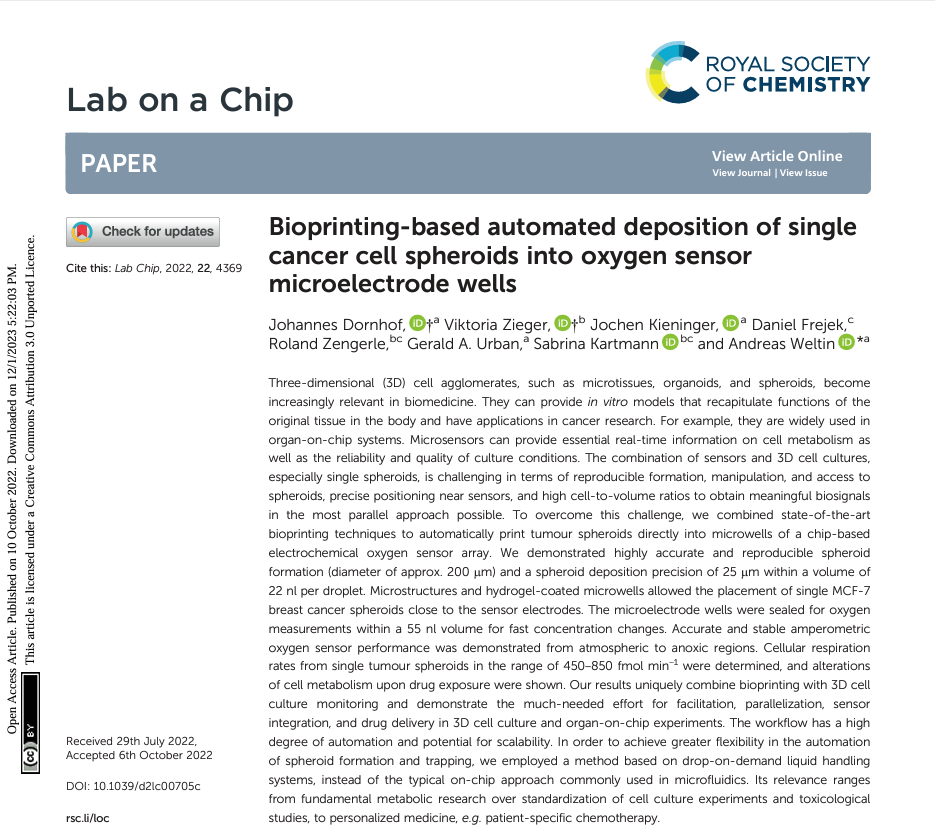The Royal Society of Chemistry recently published Bioprinting-based automated deposition of single cancer cell spheroids into oxygen sensor microelectrode wells, which addresses the assembly of spheroids by utilizing drop-on-demand liquid handling system as an alternative to conventional on-chip systems (Fig. 1).
The researchers from IMTEK, University of Freiburg, have shown for the very first time how to integrate chip-based microsensors with advanced drop-on-demand technique to print cancer spheroids directly into microsensor wells. The authors are impressed by the Immediate Drop-on-Demand Technology (I.DOT)'s processes of automation, prospective of versatility, accuracy, reproducibility, and increased flexibility in delivering 3D cell cultures.

Figure 1. The paper Bioprinting-based automated deposition of single cancer cell spheroids into oxygen sensor microelectrode wells in the publication The Royal Society of Chemistry.
Workflow of Depositing Single Cells Onto a Biochip
The sample preparation workflow would not have been efficiently or accurately carried out without the inclusion of the I.DOT Liquid Handler, which dispensed MCF-7 human breast cancer cells (3.2 × 104 cells per mL) suspended in 3D Tumorsphere Medium XF (PromoCell, Germany) in arrays of 2 μL droplets (Fig. 2).
%202.png?width=680&height=303&name=Bioprinting-Based%20Automated%20Deposition%20of%20Single%20Cancer%20Cell%20Spheroids%20Using%20the%20I.DOT%20(The%20Royal%20Society%20of%20Chemistry)%202.png)
Figure 2. Single spheroid deposition set-up and oxygen-sensing microwells workflow, which included the I.DOT Liquid Handler (DISPENDIX) to dispense MCF-7 breast cancer cells in arrays of 2 μL droplets. Image modified from Dornhof et al. (2022).
We at DISPENDIX are thrilled about the I.DOT Non-Contact Dispenser's crucial role in this workflow since it may provide new insights on fundamental metabolic research, to toxicological studies and cell culture standardization, to personalized medicine.
The following are some benefits of using I.DOT Liquid Handler for dispensing single cells and cell suspensions on biosensor chips:
Precision and Control
The challenges of dispensing cell cultures, particularly single spheroids, in terms of repeatable formation, manipulation, and precisely placing on target are now addressed by the I.DOT Non-Contact Dispenser, in which droplets are dispensed via pressurized microtubes which are compatible with a wide range of samples and provide a more straightforward implementation.
Minimized Contamination, Reduced Sample Waste, Flexibility
Owing to its versatility, the I.DOT Non-Contact Dispenser offers an intriguing simple method for integrating various cell types together if needed. Additionally, by switching contaminated parts after each use, it reduces the risk of cross-contamination in handling procedures for spheroid deposition.
High-Throughput, Automation and Reproducibility
Bioprinting using the I.DOT Non-Contact Dispenser enables the advancement towards the critical simplification, repeatability, and scaling up of cell culture inspections. The adoption rate of microsystems and microsensors into higher throughput cell biology lab routines will eventually increase with such efforts to decrease overall workload and improve experiment standardization and reliability.
Embrace the Future of Precision and Efficiency in Cell Handling
Experience the power of Immediate Drop-on-Demand Technology (I.DOT) for unparalleled control in dispensing single cells and cell suspensions. Revolutionize your research and discovery – seize the moment, upgrade your techniques, and unlock new possibilities!
Book a demo today!
References
Chen H, Wu Z, Gong Z, Xia Y, Li J, Du L, Zhang Y, Gao X, Fan Z, Hu H, Qian Q, Ding Z, Guo S. Acoustic Bioprinting of Patient-Derived Organoids for Predicting Cancer Therapy Responses. Adv Healthc Mater. 2022 Jul;11(13):e2102784. doi: 10.1002/adhm.202102784. Epub 2022 Apr 13. PMID: 35358375.
Dornhof J, Zieger V, Kieninger J, Frejek D, Zengerle R, Urban GA, Kartmann S, Weltin A. Bioprinting-based automated deposition of single cancer cell spheroids into oxygen sensor microelectrode wells. Lab Chip. 2022 Nov 8;22(22):4369-4381. doi: 10.1039/d2lc00705c. PMID: 36254669.